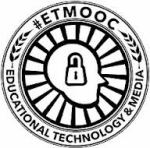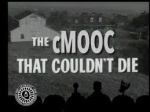We can cut off its head, fill its mouth with garlic, and drive a stake through its body, but we apparently can’t kill a well-designed, engaging, dynamic learning experience and the community of learning it spawns. Nor would we want to.
At least that’s what a cherished colleague, Alan Levine, suggests in “The cMOOC That Would Not Die,” a newly-posted article (with accompanying graphics that puckishly draw upon horror-film imagery) that captures the spirit and reach of #etmooc—the Educational Technology & Media massive open online course he helped shape and facilitate as a course “conspirator” in early 2013.
Inspired by the #etmooc community’s latest learning endeavor—a tweet chat that drew community members together for a lively hour-long discussion about integrating Twitter into learning earlier this week—Levine combines his usual wicked sense of humor and insightful perspective into a set of reflections that should inspire any trainer-teacher-learner.
I’ve been among those writing extensively about the unexpected longevity of #etmooc as a learning experience/community; a model for lifelong learning communities; and an example of how connectivist MOOCs (cMOOCs) are beginning to serve as a new form of (collaboratively-produced) textbook; in fact, I’ve probably produced enough to kill a small forest of virtual trees, and am far from finished with the topic. But none of that stops me from eagerly reading and learning from Levine’s “cMOOC That Would Not Die” and recognizing it as a manifestation of the very thing it is exploring.
The playfulness with which he tackles his topic reflects the playfulness that was at the heart of the learning process in #etmooc (and, for that matter, almost every significant learning experience I can remember having). That same playfulness is certainly one of the elements that binds members of the #etmooc community together, as anyone reading the slightly-edited transcript of the integrating-Twitter-into-learning session can’t help but notice. The sense of camaraderie is palpable, and when I talk with friends and colleagues about the value of engagement in training-teaching-learning, I often wonder aloud why so many people seem to be reticent about fostering a sense of community in the learning process.
 Levine’s obvious passion for #etmoocers’ continuing levels of engagement—the community had produced tens of thousands of tweets and 4,746 posts from 513 blogs before he wrote his article; his latest contribution pushed it to 4,747 posts—reflects the same passion that continues to draw #etmooc community members together through tweet chats, Google Hangouts, and other online platforms. And, he notes, it’s not about massive numbers of participants; it’s about the quality and openness of the engagement: “I will cherish and take this kind of experience any day over some massive MOOC of tens of thousands of enrollees, 2% or so who stick around, and [whose] corpus remains stockpiled behind a login.”
Levine’s obvious passion for #etmoocers’ continuing levels of engagement—the community had produced tens of thousands of tweets and 4,746 posts from 513 blogs before he wrote his article; his latest contribution pushed it to 4,747 posts—reflects the same passion that continues to draw #etmooc community members together through tweet chats, Google Hangouts, and other online platforms. And, he notes, it’s not about massive numbers of participants; it’s about the quality and openness of the engagement: “I will cherish and take this kind of experience any day over some massive MOOC of tens of thousands of enrollees, 2% or so who stick around, and [whose] corpus remains stockpiled behind a login.”
His reflections further serve as a manifestation how he and other #etmooc community members learn via extended cross-platform asynchronous exchanges that inspire additional collaborations: he blogs; we read; we respond via the sort of linked response I’m producing here; and we extend the conversation via comments on his own blog site as well as via tweets that call attention to his blogged reflections—a process that is continuing to unfold even as I write these words.
As I often note in learning sessions I facilitate, this is a wonderfully messy and engaging approach to learning—one that offers numerous rewards while also inspiring us to learn how to learn through entirely different approaches to learning than we ever expected to encounter. It’s what many of us learned, from Dave Cormier, to refer to and think of as rhizomatic learning—learning that expands as rapidly and expansively as rhizomes do.
 But when all is said and done, it all comes down to something Levine facetiously asserts at the beginning of his article: “Someone never told the folks who participated in the 2013 Educational Technology and Media MOOC that it was over. They are still at it.” And the perfect riposte comes in a form of a tweet posted by Thomas Okon (@thomasjokon) in March 2013 as the last of the formal #etmooc modules had been completed and people were talking about how sorry they were that the course was “over”: “Over? Was it over when the Germans… Its not over till we say it is. Im keeping my column in Tweet deck!”
But when all is said and done, it all comes down to something Levine facetiously asserts at the beginning of his article: “Someone never told the folks who participated in the 2013 Educational Technology and Media MOOC that it was over. They are still at it.” And the perfect riposte comes in a form of a tweet posted by Thomas Okon (@thomasjokon) in March 2013 as the last of the formal #etmooc modules had been completed and people were talking about how sorry they were that the course was “over”: “Over? Was it over when the Germans… Its not over till we say it is. Im keeping my column in Tweet deck!”
Okon was—and remains—right. We continue to learn together in a variety of settings. To work together (several of us went on to design and facilitate another connectivist MOOC). To write about it individually and as co-writers. And to engage in teaching-training-learning-doing so that the community continues to grow by acquiring new members and inspiring others to produce their own versions of our successes.

